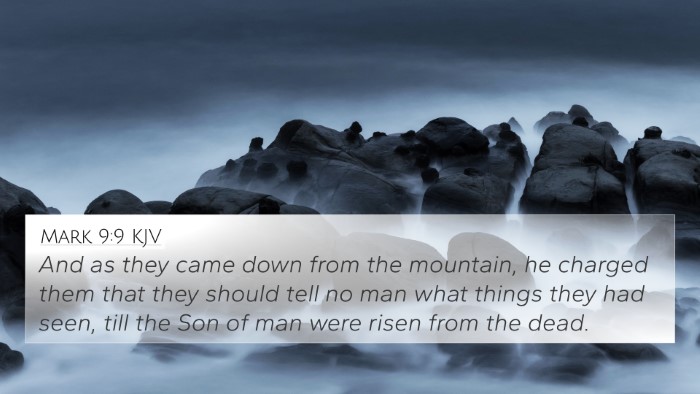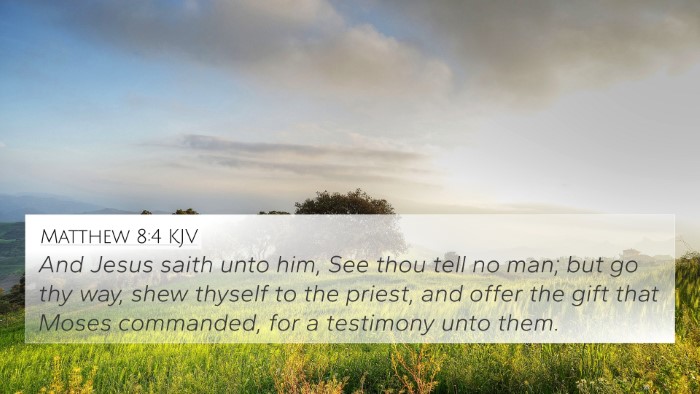Understanding Mark 8:30
Mark 8:30 states: "And he charged them that they should tell no man of him." This verse follows Peter's confession that Jesus is the Christ, highlighting a significant turning point in the Gospels and Jesus' ministry.
Contextual Analysis
This verse occurs after Peter's declaration, emphasizing the divine revelation of Jesus' identity. Jesus instructs his disciples to keep this revelation secret, which Matthew Henry notes is due to the misconception surrounding the Messiah's role that was prevalent among the people of Israel.
Key Themes
- Messianic Secret: This theme pervades Mark's Gospel and reflects Jesus' intention to reveal his identity only at the right moment.
- Discipleship: Jesus emphasizes the responsibility of his followers to understand and share this truth appropriately.
- Divine Timing: The timing of revelation plays a crucial role as Jesus prepares his disciples for the impending events of his ministry.
Commentary Insights
Matthew Henry reflects on the significance of Peter's declaration and Jesus' directive. He suggests that secrecy about Jesus’ identity served to prepare the disciples, preventing premature notions of political messiahship.
Albert Barnes adds that this command not to tell others highlights Jesus’ understanding of public perception. He wanted his true mission and identity revealed in his timing, especially leading up to the crucifixion.
Adam Clarke comments on the implications of this command, stating that Jesus was aware of the dangers of misunderstanding his mission. The focus was on teaching the disciples about sacrifice rather than popular acclaim.
Cross-References for Mark 8:30
For a comprehensive understanding and thematic connections in the Bible, consider the following cross-referenced verses:
- Matthew 16:20: Similar to Mark 8:30, where Peter's confession is followed by Jesus instructing them not to reveal his identity.
- John 6:15: Discusses the crowd seeking to make Jesus king after the feeding of the 5000, emphasizing the misconceptions of his role.
- Luke 9:21: Another account where Jesus forbids the disciples to tell about him, correlating with his goals of teaching and preparation.
- Isaiah 53:3: Foretells the suffering servant, depicting the contrasts of recognition and rejection, linking to Jesus' hidden identity.
- Mark 1:34: Jesus often silences demons and those who identify him, reinforcing the messianic secrecy in his mission.
- John 7:4: The disciples encourage Jesus to reveal himself publicly, showcasing their misunderstanding of his mission.
- Revelation 19:11-16: Highlights the true identity of Jesus revealed in glory, contrasting with the humility he demonstrated during his Earthly ministry.
- Mark 9:9: Jesus again instructs the disciples following the transfiguration not to tell others what they had seen until after his resurrection.
- Matthew 17:9: Reinforces the theme of secrecy post-transfiguration, linking recognition with the divine plan.
- Romans 16:25-26: Discusses the secret kept in silence for long ages, now revealed, connecting to the broader revelation of God’s plan.
Thematic Connections
This verse serves as a nexus for understanding the theme of secrecy surrounding Christ's identity and mission, which runs throughout the New Testament. Moreover, it points to the ongoing dialogue between Old Testament prophecies and New Testament fulfillment, encapsulating the complex unveiling of who Jesus truly is.
Tools for Further Study
- Bible Concordance: To find related verses and deeper connections.
- Bible Cross-Reference Guide: Helpful for linking scripture passages thematically.
- Cross-Reference Bible Study: Engaging methods for identifying and utilizing cross-references in scripture.
- Bible Reference Resources: Enhance understanding through comprehensive materials on cross-referencing.
- Bible Chain References: Study series of verses that explain key biblical themes in depth.
Conclusion
Mark 8:30 is a pivotal moment that underscores critical themes of recognition, secrecy, and divine timing. For those engaging in Bible study, the inter-Biblical dialogue presented through cross-referencing this verse with others enriches the understanding of Jesus’ mission and identity. A deeper exploration of these themes enhances our understanding of the entire biblical narrative, revealing the threads that connect the Old and New Testaments.








